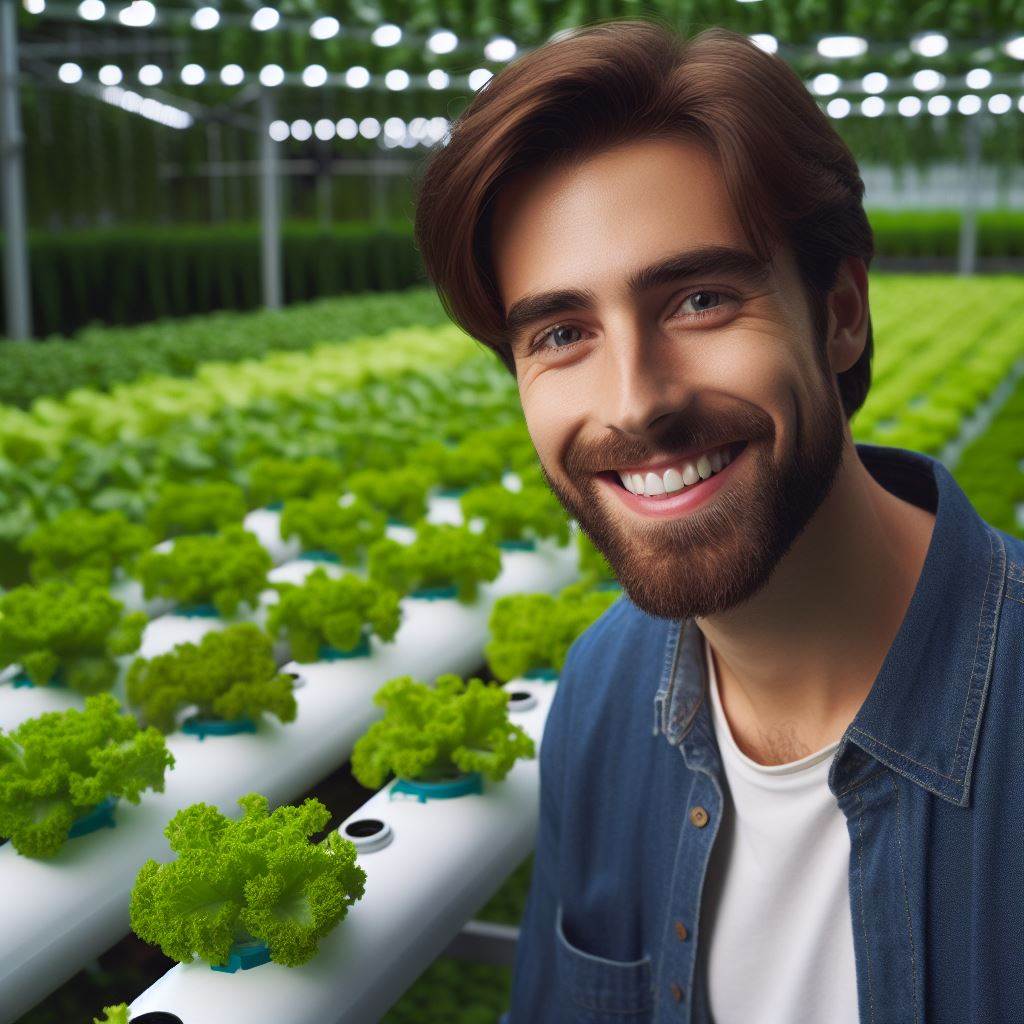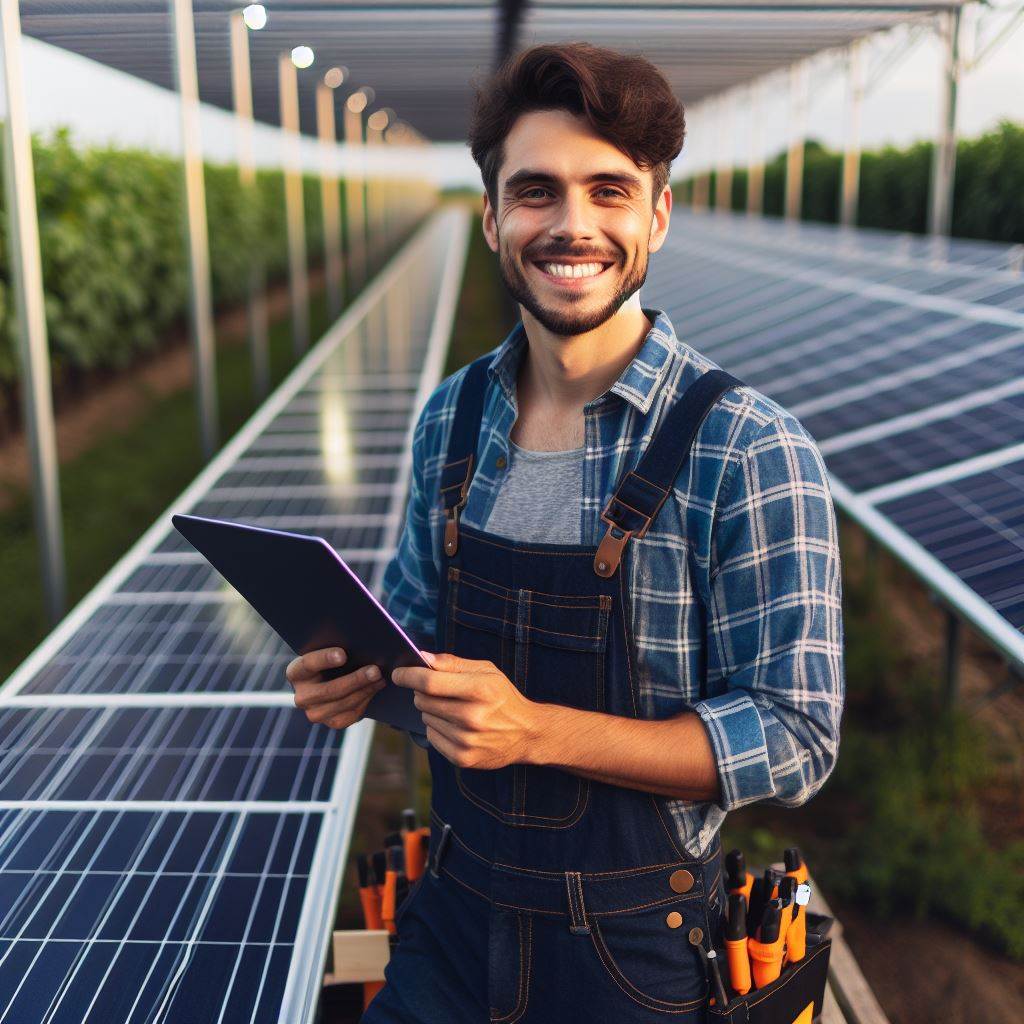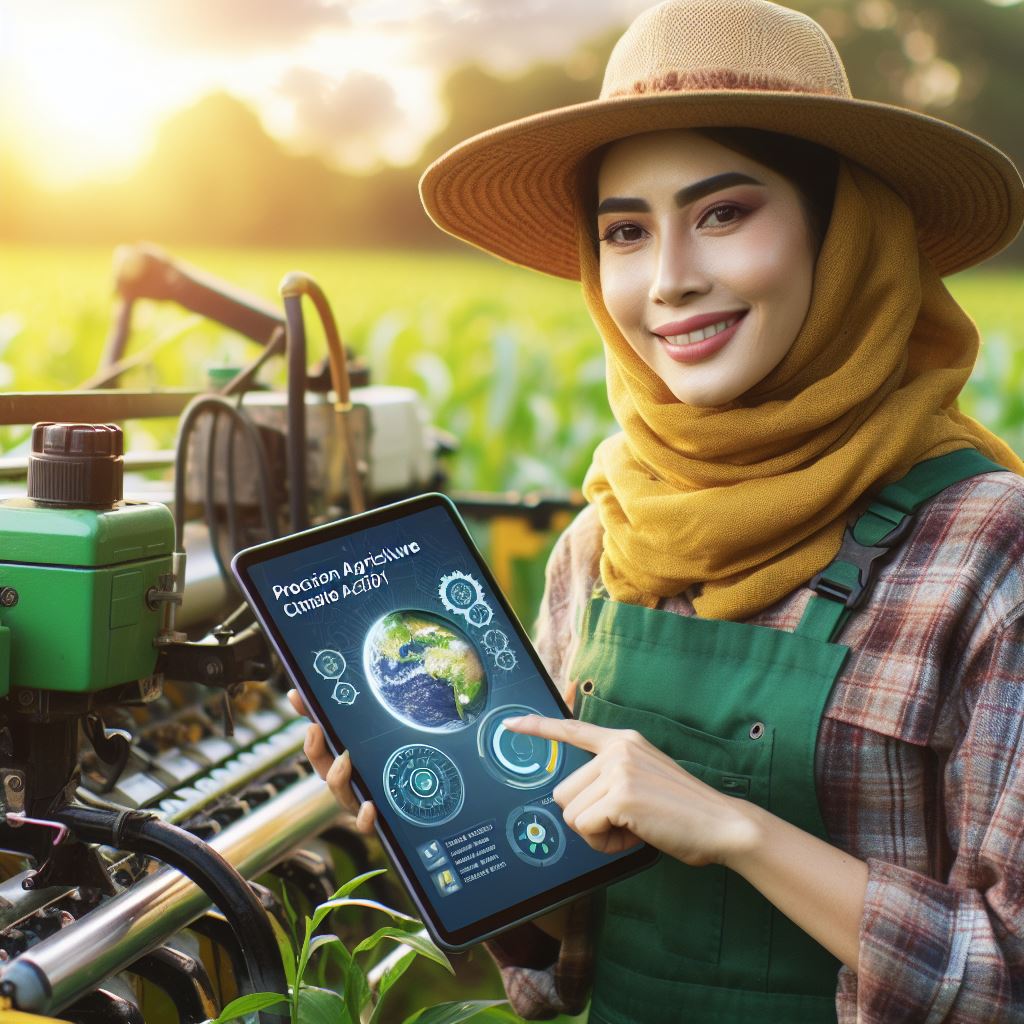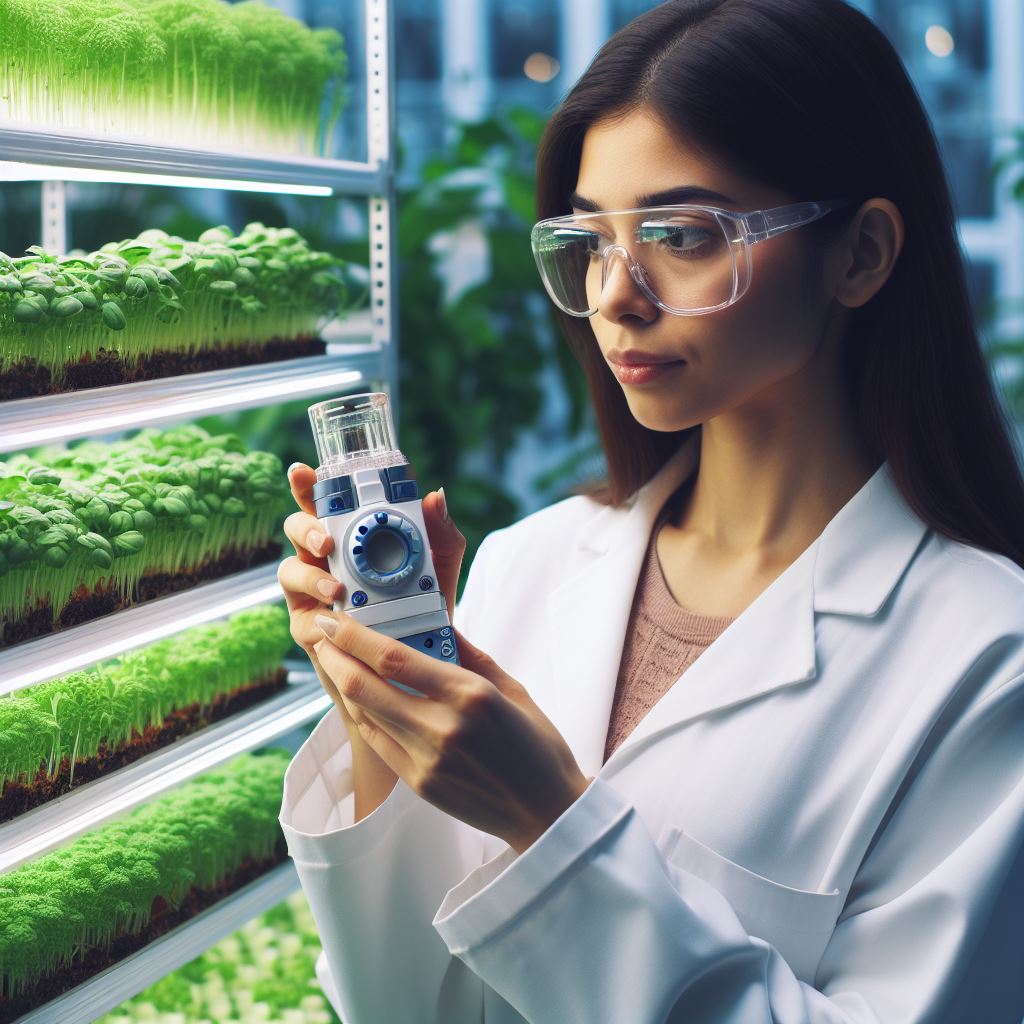Introduction
Hydroponics is an innovative farming technique that replaces soil with water and nutrient solutions.
It offers a modern and efficient way of cultivating crops indoors, without relying on traditional agricultural practices.
Climate-resilient farming is crucial in the face of changing weather patterns and increasing environmental challenges.
Sustainable solutions like hydroponics are needed to address the limitations of conventional farming methods.
By reducing dependency on rainfall, hydroponics ensures stable crop production throughout the year.
The controlled environment of hydroponics allows for the elimination of pests and diseases, minimizing the need for pesticides.
Water conservation is a major advantage of hydroponics, as it uses only 10% of the water required by conventional farming.
Furthermore, hydroponics reduces the risk of soil erosion and depletion, preserving land for future generations.
The ability to grow crops in urban areas also reduces transportation and storage costs, making food production more economical.
Hydroponics-based farming systems can be customized to suit specific crop requirements, maximizing yields and minimizing waste.
In fact, hydroponics offers a sustainable and climate-resilient solution to modern farming challenges.
By embracing this innovative technique, we can ensure food security, environmental conservation, and economic stability.
What is hydroponics?
Hydroponics, a soilless farming technique, has emerged as a game-changer in the field of agriculture.
It offers a sustainable solution to combat the challenges posed by climate change.
Let’s delve deeper to understand the marvels of hydroponics.
Hydroponics is a method of growing plants without using soil.
Instead, plants are grown in nutrient-rich water that is directly infused with essential minerals they need for growth.
The Basic Principles of Hydroponics
- Water serves as a growing medium to provide hydration to the plants.
- Nutrient solutions are utilized to supply plants with essential elements needed for their nourishment.
- Artificial lighting simulates sunlight to facilitate the process of photosynthesis.
- Efficient ventilation ensures proper oxygen supply to the plants.
- Automated systems control and monitor factors such as temperature, pH, and nutrient levels.
Main Components of a Hydroponic System
- Water: Acts as the growing medium in hydroponics and comes in various forms, such as nutrient film technique, deep water culture, or aeroponics.
- Nutrient Solution: A carefully formulated mixture of minerals and fertilizers dissolved in water, providing plants with their required nutrients.
- Growing Medium: Provides mechanical support for plants’ roots and aids in moisture retention. Common mediums include coconut coir, perlite, or Rockwool cubes.
Advantages of Hydroponics over Traditional Soil-Based Farming Methods
- Maximized Crop Yield: Hydroponics systems grow plants in optimal conditions, enabling accelerated growth rates and increased yield compared to soil-based farming.
- Water Conservation: Hydroponics utilizes up to 90% less water compared to traditional agriculture since the water is recirculated within the system.
- Efficient Use of Space: Vertical farming techniques in hydroponics allow for higher plant density, allowing farmers to grow more crops in limited space.
- Reduced Dependency on Fertilizers and Pesticides: In hydroponics, the nutrient solution is carefully calibrated, reducing the need for excessive use of fertilizers and pesticides.
- Climate Resilience: Hydroponic systems are climate-neutral, enabling year-round cultivation regardless of weather conditions, providing stability to food production.
- Minimized Soil Erosion: With hydroponics, there is no soil needed, which reduces the risk of erosion caused by wind or water.
- Controllable Growth Conditions: Hydroponics allows precise control over factors such as temperature, pH, and nutrient levels, optimizing growth and minimizing crop losses.
- Elimination of Soil-Borne Diseases: Since hydroponics eliminates soil, the risk of soil-borne diseases and pests is significantly reduced.
Hydroponics has transformed agriculture by eliminating the challenges associated with traditional soil-based farming methods.
It offers a sustainable and climate-resilient solution to meet the demands of an ever-growing global population.
As we embrace the future, hydroponics paves the way for a more efficient and environmentally friendly farming industry.
It is high time we acknowledge and adopt this revolutionary technique to secure food sustainability for generations to come.
The Role of Hydroponics in Climate-Resilient Farming
Hydroponics: Tackling Climate Change
Climate change poses significant challenges to agriculture, including extreme weather events, water scarcity, and shifting growing seasons.
However, hydroponics offers a sustainable solution that enables farmers to adapt and thrive in changing climates.
How hydroponics can help mitigate the impact of climate change on agriculture
One of the key advantages of hydroponics is its ability to mitigate the impact of climate change on agriculture.
Traditional farming heavily relies on an uncertain combination of external factors such as weather conditions, soil quality, and access to water.
In contrast, hydroponics provides an artificial environment where farmers have greater control over the growth conditions.
How hydroponics enables farmers to control environmental conditions (temperature, moisture, light) to ensure optimal growth
Through hydroponics, farmers can adjust environmental parameters such as temperature, moisture, and light to create an optimal growing environment for plants.
This control allows farmers to eliminate or reduce the risks associated with extreme weather events, such as droughts, floods, or heatwaves.
By fine-tuning these factors, hydroponics ensures the plants’ needs are met, promoting healthier and more productive crops.
How hydroponics minimizes dependency on arable land, reducing deforestation and habitat destruction
Furthermore, hydroponics enables farming in areas where traditional agriculture is not viable due to adverse climatic conditions or limited arable land.
Hydroponic systems can be set up indoors or in controlled environments, making it possible to grow crops in regions with harsh climates or urban areas with limited space.
This versatility reduces the dependency on fertile land, which helps preserve natural habitats and minimize deforestation.
The efficient use of resources is another advantage of hydroponics.
Unlike traditional farming that requires large amounts of water and fertilizers, hydroponics uses a fraction of these resources.
The recirculation of nutrient solutions in hydroponic systems minimizes water usage, making it a more sustainable alternative.
This aspect is crucial in the face of water scarcity challenges due to climate change.
In addition to its climate resilience, hydroponics presents other unique benefits.
By removing the need for soil, hydroponics eliminates soil-borne diseases and pests, reducing the reliance on chemical pesticides.
As a result, hydroponics offers a safer and healthier way of growing food.
In short, hydroponics plays a vital role in climate-resilient farming.
Its ability to control environmental conditions, reduce dependency on arable land, and efficiently utilize resources make it an innovative and sustainable solution for agriculture in the face of climate change.
By embracing hydroponics, farmers can adapt, overcome challenges, and ensure food security for future generations.
Water conservation in hydroponics
Water conservation is a critical aspect of hydroponics, making it a sustainable farming method.
Water-saving benefits of hydroponics compared to conventional farming
- Hydroponics uses up to 90% less water compared to traditional soil-based farming.
- In hydroponics, water is recirculated within the system, reducing the need for constant irrigation.
- The closed-loop system prevents water wastage through evaporation or runoff.
- Water-efficient technologies in hydroponics, such as drip irrigation, minimize water usage.
Water recycling and reuse in hydroponics
- Hydroponics allows for the recycling and reuse of water, leading to minimal water wastage.
- The water used in hydroponics can be treated and reused, reducing overall water consumption.
- Nutrient-rich water from hydroponic systems can be filtered and reinjected into the growing environment.
- The ability to reuse water provides a sustainable solution for reducing water stress.
The potential of hydroponics to alleviate water scarcity in regions affected by climate change
- Hydroponics can be practiced in arid regions with limited access to water.
- It eliminates the need for large amounts of water required for conventional farming methods.
- By utilizing water-efficient techniques, hydroponics reduces the strain on water sources.
- Climate change exacerbates water scarcity, but hydroponics offers an adaptable and resilient solution.
- Hydroponics can be implemented in urban areas, minimizing the strain on rural water supplies.
In general, hydroponics stands out as a climate-resilient farming technique that addresses the urgent need for water conservation.
Its water-saving benefits, such as reduced water usage and the potential for recycling and reuse, are unparalleled compared to conventional farming methods.
Transform Your Agribusiness
Unlock your farm's potential with expert advice tailored to your needs. Get actionable steps that drive real results.
Get StartedBy alleviating water scarcity in regions affected by climate change, hydroponics presents a promising solution to ensure food security and sustainable agricultural practices.
Read: Facing Climate Change: Crop Diversity’s Role

Nutrient efficiency in hydroponics
In hydroponics, nutrient efficiency is a key advantage that allows precise control over nutrient uptake by plants.
One of the primary reasons hydroponics is considered the future of farming is its ability to maximize nutrient absorption and minimize waste.
Traditional soil-based farming often results in nutrient loss due to leaching, volatilization, and denitrification.
In hydroponics, nutrients are delivered directly to the plant roots in a water-based solution, ensuring that plants receive the exact nutrients they need, when they need them.
By tailoring nutrient solutions to specific crop requirements, hydroponic systems provide an optimized environment for plant growth.
The use of controlled nutrient solutions tailor-made for specific crop requirements
The use of controlled nutrient solutions is a major advantage in hydroponics, as it allows farmers to customize the nutrient composition based on the specific needs of different plants.
This customization is particularly valuable when growing multiple crops in the same system, as each crop may require different nutrient ratios.
For example, leafy greens like lettuce and spinach thrive on higher nitrogen levels, while fruit-bearing plants like tomatoes and peppers require more phosphorus and potassium.
With hydroponics, farmers have the ability to tailor the nutrient solution to meet the precise needs of each crop, maximizing growth and yield.
Furthermore, hydroponic systems allow for real-time monitoring and adjustment of nutrient levels, ensuring plants always have access to the optimal amount of nutrients.
This fine-tuning of nutrient delivery is crucial in achieving maximum nutrient efficiency.
In traditional soil-based farming, plants often struggle to access nutrients, as they may be unevenly distributed throughout the soil or bound to organic matter.
Hydroponic systems eliminate this problem by providing a consistent and easily accessible nutrient supply to the plants.
The roots of hydroponically grown plants are constantly submerged in a nutrient-rich solution, allowing for efficient absorption of essential minerals.
Without the need to search for nutrients in the soil, plants can allocate more energy towards growth and development.
Moreover, the controlled environment of hydroponics ensures that nutrient levels remain stable, preventing the risk of deficiency or excess.
Optimizing Nutrient Efficiency in Hydroponic Farming
In soil-based farming, excessive use of fertilizers can lead to environmental pollution, as nutrients may leach into groundwater or runoff into nearby water bodies.
Hydroponics greatly reduces the risk of nutrient pollution, as the closed-loop systems minimize nutrient waste and capture any runoff for reuse.
This not only helps conserve water but also prevents the release of excess nutrients into the environment.
In review, nutrient efficiency is a significant advantage of hydroponics, allowing precise control over nutrient uptake by plants.
By maximizing nutrient absorption and minimizing waste, hydroponics ensures plants receive the exact nutrients they need, leading to optimized growth and higher yields.
The use of tailor-made nutrient solutions further enhances nutrient efficiency, as it allows farmers to meet the specific requirements of different crops.
Showcase Your Farming Business
Publish your professional farming services profile on our blog for a one-time fee of $200 and reach a dedicated audience of farmers and agribusiness owners.
Publish Your ProfileOverall, hydroponics presents a sustainable and climate-resilient approach to farming, offering a promising solution for future food production.
Read: AI in Agriculture: Facing Climate Change
Crop productivity and yield in hydroponics
Hydroponics, as an innovative farming method, has proven to deliver higher crop yields compared to traditional farming methods.
Numerous studies and examples have showcased this remarkable potential.
Studies and examples showcasing higher crop yields
A) In a study conducted at the University of Arizona, lettuce grown hydroponically recorded a yield of 20-30% more than conventionally grown lettuce.
This indicates the efficiency and productivity of hydroponics.
B) The Netherlands is renowned for its advanced hydroponic systems, and their tomato production provides an excellent example.
Dutch growers achieve yields of up to 80 kilograms per square meter, whereas traditional soil-based farming yields only 50 kilograms per square meter.
C) Strawberries grown hydroponically have also shown remarkable results.
A study by researchers at Purdue University demonstrated that strawberries grown hydroponically produced significantly higher yields compared to those grown conventionally.
Year-round cultivation and multiple cropping cycles
One of the significant advantages of hydroponics is its ability to enable year-round cultivation.
By creating controlled environments, hydroponic systems enable farmers to bypass seasonal limitations and grow crops throughout the year.
Traditional farming methods heavily rely on favorable weather conditions and seasons, which can often be unpredictable.
However, hydroponics eliminates this constraint and ensures a consistent supply of fresh produce regardless of the external environment.
Additionally, hydroponics allows for multiple cropping cycles.
As the growth of plants is not dependent on soil fertility, once a crop is harvested, the system can be quickly replenished with new plants, leading to increased productivity and yield.
Potential of hydroponics to increase food production
In today’s rapidly growing global population, there is an immense pressure to increase food production.
Hydroponics provides a promising solution to meet these demands.
By utilizing hydroponic systems, farmers can achieve higher crop yields, regardless of limited arable land availability.
This method allows crops to be grown vertically, optimizing space utilization and increasing overall productivity.
Moreover, hydroponics enables the cultivation of crops in urban areas.
By utilizing unused spaces such as rooftops and indoor settings, hydroponics brings farming closer to consumers, reducing transportation costs and carbon footprints.
The integration of advanced technologies, such as artificial lighting and automated nutrient supply systems in hydroponics, further contributes to its potential for increased food production.
Hydroponics undoubtedly showcases higher crop yields, facilitated by its ability to enable year-round cultivation and multiple cropping cycles.
This innovative farming method holds immense potential in meeting the global demands for food production in a climate-resilient manner.
As we move towards a more sustainable future, hydroponics can play a critical role in ensuring food security and reducing the environmental footprint of agriculture.
Read: Smart Drones: Revolutionizing Farming
Environmental Sustainability and Hydroponics
Eliminating the Use of Harmful Pesticides and Herbicides
Hydroponics, as an innovative farming technique, offers numerous environmental benefits.
One of the most significant advantages is the elimination of harmful pesticides and herbicides.
Traditional farming methods heavily rely on the use of chemical-based pesticides and herbicides to control pests and weeds.
Unfortunately, these chemicals can have detrimental effects on the environment, causing pollution of nearby water sources and soil degradation.
With hydroponics, however, the need for pesticides and herbicides is greatly reduced.
By growing plants in a controlled indoor environment, pests and weeds are less likely to infest the crops.
This eliminates the need for chemical intervention, making hydroponics a more sustainable farming practice.
Reducing Soil Erosion and Contamination
Another environmental benefit of hydroponics is the significant reduction in soil erosion and contamination.
Traditional farming practices often involve extensive plowing, which leaves soil susceptible to erosion caused by wind and water.
Eroded soil can carry valuable nutrients away and result in barren landscapes.
Moreover, when it rains, pesticide residues and fertilizers from traditional farms can seep into the ground, contaminating the soil.
In hydroponics, plants are grown without soil, eliminating the risk of erosion.
The use of inert growing media, such as perlite or coconut coir, provides stability and prevents soil loss.
Additionally, since hydroponics relies on nutrient-rich water solutions, there is no need for chemical fertilizers that can contaminate the soil.
Promoting Organic Farming Practices and Food Safety
Hydroponics shows immense potential in promoting organic farming practices and ensuring food safety.
Organic farming avoids the use of synthetic fertilizers and pesticides that can harm both human health and the environment.
By eliminating the need for chemical inputs, hydroponics allows farmers to adopt organic farming techniques easily.
This means that hydroponically-grown produce can be certified organic, appealing to consumers who prioritize organic and sustainable food options.
Furthermore, hydroponics minimizes the risk of foodborne illnesses.
Hydroponic systems provide a controlled environment, reducing the potential for contamination by pathogens such as E. coli or salmonella.
The use of clean water sources and strict sanitation protocols make hydroponics a safer option for producing fresh and healthy food.
In a nutshell, hydroponics plays a pivotal role in promoting environmental sustainability in farming.
By eliminating harmful pesticides and herbicides, reducing soil erosion and contamination, and supporting organic farming practices and food safety, hydroponics offers a climate-resilient and eco-friendly solution for the future of agriculture.
Read: Climate-Smart Farming Techniques
Challenges and limitations of hydroponics
Hydroponics, while offering numerous benefits, also comes with its fair share of challenges and limitations.
In this section, we will discuss some key issues that need to be addressed when considering hydroponic systems.
- Initial high setup costs: One of the major challenges in adopting hydroponics is the high initial costs associated with setting up the system. The technology and infrastructure required for hydroponic farming can be expensive.
- Need for technical knowledge and expertise: Another challenge is the need for technical knowledge and expertise to operate hydroponic systems effectively. It is not a simple plug-and-play method of farming; it requires understanding and skills in various aspects, including nutrient management, pH control, and plant growth techniques.
- Concerns regarding energy consumption: Energy consumption is a significant concern in hydroponics. The equipment used, such as pumps, lights, and climate control systems, require electricity to function. This can lead to high energy consumption and reliance on non-renewable energy sources.
- Environmental impact of equipment: The environmental impact of the equipment used in hydroponics is another challenge. Manufacturing these systems and their components contribute to carbon emissions and waste generation. The materials used, such as plastics and metals, also have varying degrees of environmental impact.
While these challenges may seem daunting, it is essential to consider potential solutions and advancements in hydroponics that aim to overcome these limitations.
Possible solutions
- Cost-effective options: Research and development in hydroponics are focused on developing cost-effective alternatives to the traditional high-cost setups. This includes the use of affordable materials and simplified designs that still deliver optimal growing conditions.
- Training and education: Addressing the need for technical knowledge and expertise, training programs and educational resources have emerged to equip individuals with the necessary skills for hydroponic farming. This helps overcome the barrier of limited knowledge and promotes effective system operation.
- Energy-efficient practices: The push for energy efficiency in hydroponics has led to the development of energy-saving technologies. LED lights with lower energy consumption and smart control systems that optimize energy usage are being adopted to reduce the environmental impact of hydroponic systems.
- Sustainable materials and practices: Efforts are being made to reduce the environmental footprint of hydroponics through the use of sustainable materials and practices. This includes recycling and repurposing materials, reducing waste generation, and exploring alternatives to conventional plastic components.
While hydroponics offers a promising future for climate-resilient farming, it is crucial to acknowledge and address the challenges and limitations associated with this method.
By investing in research, training, and sustainable practices, we can overcome these hurdles and unlock the full potential of hydroponics in feeding a growing global population.
Gain More Insights: Crops vs. Climate: Diversity for Stability
Conclusion
Hydroponics stands as the beacon of hope for climate-resilient farming in the future.
Its potential is vast and promising. Emphasizing numerous environmental and economic benefits, it offers a sustainable alternative to traditional agriculture.
Environmental benefits encompass water conservation, reduced pesticide usage, and minimal soil erosion.
Economic advantages include higher yields, efficient land utilization, and decreased dependency on external resources.
Encouraging further research and widespread adoption of hydroponics is imperative.
It not only ensures food security but also mitigates the adverse effects of climate change on agriculture.
Efforts to optimize hydroponic systems should be intensified.
This involves exploring innovative techniques, enhancing efficiency, and addressing challenges such as energy consumption and nutrient management.
The journey towards sustainable agricultural practices hinges upon embracing hydroponics.
Its integration into mainstream farming methods holds the key to resilience against climatic uncertainties and resource constraints.
Overall, the future of farming lies in the hands of hydroponics.
It offers a pathway towards environmental sustainability, economic prosperity, and food security.
Now is the time to invest in research, education, and infrastructure to realize its full potential and shape a resilient agricultural landscape for generations to come.




